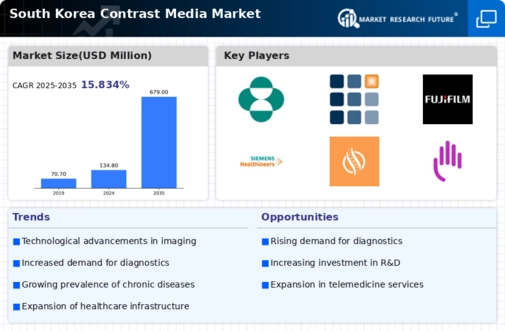Increase in Healthcare Expenditure
The rise in healthcare expenditure in South Korea is a crucial driver for the contrast media market. With the government and private sectors investing heavily in healthcare infrastructure, the availability of advanced imaging technologies is improving. In 2025, healthcare spending is projected to reach approximately $200 billion, with a significant portion allocated to diagnostic imaging services. This increase in funding is likely to enhance the capabilities of healthcare facilities, leading to a higher demand for contrast media. The contrast media market stands to benefit from this trend, as more hospitals and clinics seek to upgrade their imaging equipment and improve diagnostic accuracy. Consequently, the growth in healthcare expenditure is expected to have a positive impact on the market.
Growing Demand for Diagnostic Imaging
The increasing demand for diagnostic imaging in South Korea is a pivotal driver for the contrast media market. As healthcare providers strive to enhance patient outcomes, the utilization of advanced imaging techniques has surged. This trend is reflected in the rising number of imaging procedures performed annually, which has been estimated to reach over 20 million by 2025. The contrast media market is experiencing a corresponding growth, as these agents are essential for improving the clarity and detail of imaging results. Furthermore, the South Korean government's initiatives to promote early disease detection and preventive healthcare are likely to further bolster the demand for diagnostic imaging, thereby positively impacting the contrast media market.
Technological Innovations in Contrast Agents
Technological innovations in contrast agents are significantly influencing the contrast media market in South Korea. Recent advancements have led to the development of new formulations that enhance the safety and efficacy of these agents. For instance, the introduction of non-ionic, water-soluble contrast media has reduced adverse reactions, making imaging procedures safer for patients. The market is projected to grow at a CAGR of approximately 6% through 2025, driven by these innovations. Additionally, the integration of artificial intelligence in imaging technologies is expected to optimize the use of contrast agents, further propelling the market forward. As healthcare facilities adopt these advanced technologies, the demand for innovative contrast media is likely to increase.
Aging Population and Associated Health Issues
The aging population in South Korea is a significant driver for the contrast media market. As the demographic shifts towards an older population, the prevalence of age-related health issues, such as cardiovascular diseases and cancers, is likely to increase. This trend necessitates the use of advanced imaging techniques for accurate diagnosis and treatment planning. The contrast media market is poised to expand as healthcare providers respond to the growing need for effective diagnostic tools. By 2025, it is anticipated that the number of imaging procedures will rise, driven by the need to manage chronic conditions prevalent among the elderly. This demographic shift underscores the importance of contrast media in enhancing diagnostic capabilities.
Regulatory Framework and Market Accessibility
The regulatory framework in South Korea plays a vital role in shaping the contrast media market. The government has established guidelines that facilitate the approval and distribution of new contrast agents, ensuring that they meet safety and efficacy standards. This supportive regulatory environment encourages innovation and market entry for new products. As a result, the contrast media market is likely to see an influx of novel agents that cater to diverse patient needs. Furthermore, the government's commitment to improving healthcare access is expected to enhance the availability of imaging services across the country. This increased accessibility may lead to a higher utilization of contrast media, thereby driving market growth.





















Leave a Comment